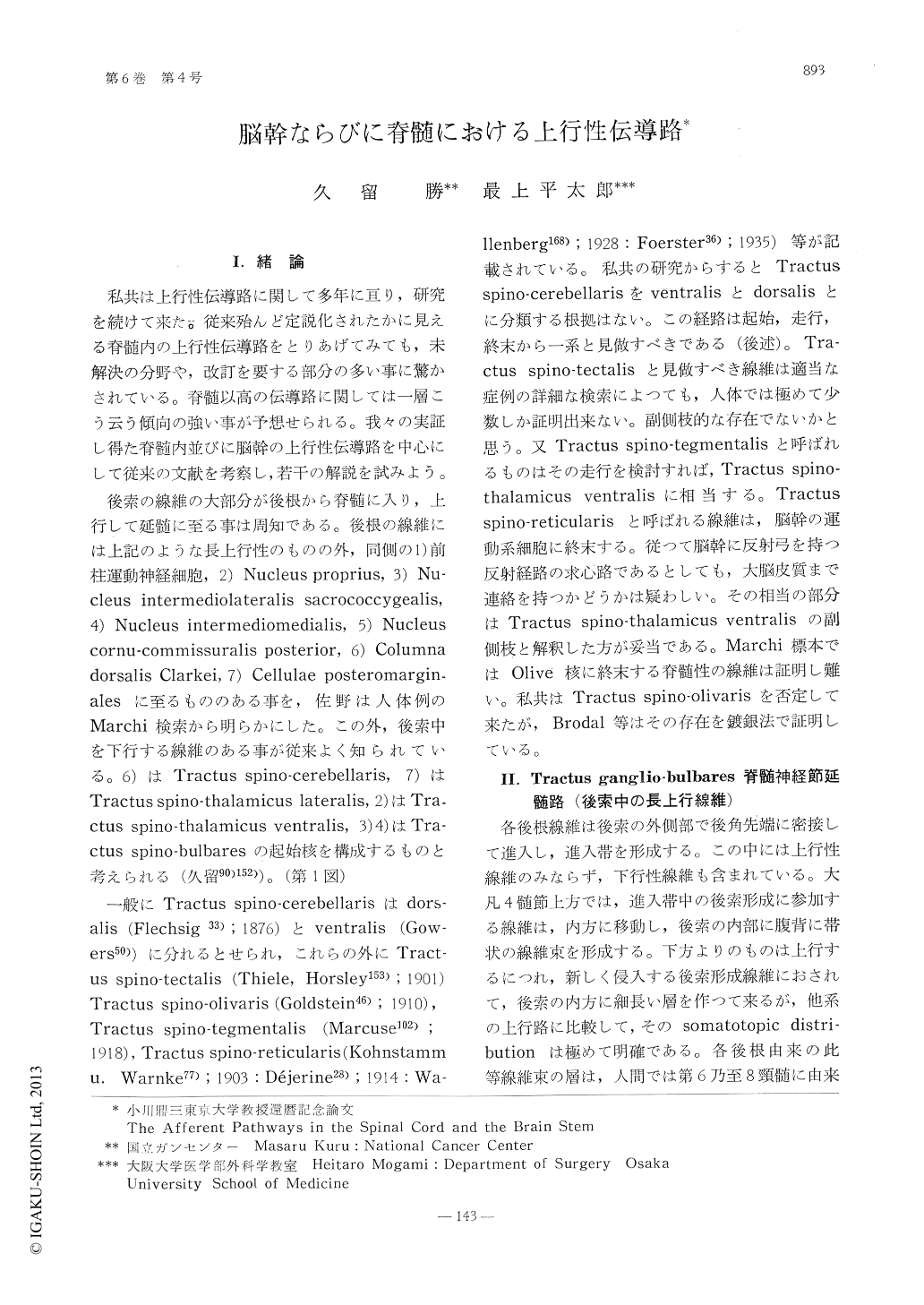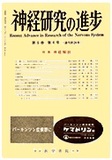Japanese
English
- 有料閲覧
- Abstract 文献概要
- 1ページ目 Look Inside
I.緒論
私共は上行性伝導路に関して多年に亘り,研究を続けて来た。従来殆んど定説化されたかに見える脊髄内の上行性伝導路をとりあげてみても,未解決の分野や,改訂を要する部分の多い事に驚かされている。脊髄以高の伝導路に関しては一層こう云う傾向の強い事が予想せられる。我々の実証し得た脊髄内並びに脳幹の上行性伝導路を中心にして従来の文献を考察し,若干の解説を試みよう。
後索の線維の大部分が後根から脊髄に入り,上行して延髄に至る事は周知である。後根の線維には上記のような長上行性のものの外,同側の1)前柱運動神経細胞,2)Nucleus proprius,3)Nucleus intermediolateralis sacrococcygealis,4)Nucleus intermediomedialis,5)Nucleus cornu-commissuralis posterior,6)Columnadorsalis Clarkei,7)Cellulae posteromarginalesに至るもののある事を,佐野は人体例のMarchi検索から明らかにした。この外,後索中を下行する線維のある事が従来よく知られている。
The present paper deals with the afferent pathways in the spinal cord and the brain stem with special reference to certain findings done in the authors' laboratory.
The spinocerebellar tract is usually classified into two, the ventral and the dorsal spino-cereoeuar tracts. This classincation is untenable since no difference can be recognized as to the origin, course and termination between the two. This tract originates in Clarke's dorsal column, ascends homolaterally and terminates in the cerebellar vermis.
The course and the site in the spinal transverse section of the ventral and lateral spino-thalamic tract in the spinal cord and the brain stem are in detail described. Their situation in the transverse section of the spinal cord was obscure, since the lateral spino-bulbar tract was ignored by most of the previous investigators. The lateral spino-thalamic tract originates from the cellulae posteromarginales of the posterior horn and mediates the sensation of pain and temperature of the body surface. The somatotopic arrangement of this tract in the spinal cord was discussed in detail. The ventral spino-thalamic tract originates in the nucleus proprius of the posterior horn and seems to conduct the sensations of touch and pressure of the protopathic nature.
Two new afferent pathways which transmit the visceral sensation were described. These tracts connect the spinal cord with the medulla oblongata. One of them, the lateral spino-bulbar tract, ascends in the lateral funiculus, and the other, the pelvic sensory vagus, ascends in the paramedian portion of the posterior funiculus. The terminations of these pathways were located closely to the vagal nuclei in the medulla oblongata. The lateral spino-bulbar tract terminates in the paraalar, juxtasolitary and paratrigeminal nuclei respectively. Pelvic sensory vagus terminates in the paraalar nucleus. Thecentripetal connections of the lateral spino-bulbar tract are comprised in the tegmental fascicle of Forel. The paraalar nucleus seems to send fibers to the contralateral medial lemniscus.
It is reasonable to classify the central pathways of trigeminal nerve into the four following groups, 1) Tr. quinto-thalamicus reticularis, 2) Tr. quinto-thalamicus lemniscalis, 3) Tr. quinto-thalamicus tenuis s. paralemniscalis, 4) Tr. quinto-thalamicus juxtagrisealis s. gustatorius, because of the existence of definite analogues to each of the spinal afferents.
Tractus quinto-thalamicus reticularis corresponds to the fascicle described by Helsel and Wallenberg. Tractus quinto-thalamicus lemniscalis signifies the ventral tegmental fascicle described by Spitzer. These two tracts correspond to the ventral spino-thalamic tract and lemniscus medialis respectively, and mediates touch and pressure sensations. Tractus quinto-thalamicus tenuis s. paralemniscalis corresponds to the lateral spino-thalamic tract and seems to mediate the sensation of pain and temperature of the face. The whole course of these tracts were definitely traced and described.
Tractus quinto-thalamicus juxtagrisealis is contained in Forel's tegmental fascicle which is identifiable with Economo's lateral tegmental fascicle. As above-mentioned, this fascicle contains also the centripetal connections of the lateral spino-bulbar tract. It mediates, therefore, the visceral sensations inclusive of the gustatory and sexual sensations.
The central courses of the vestibular system is also alluded to.

Copyright © 1962, Igaku-Shoin Ltd. All rights reserved.


